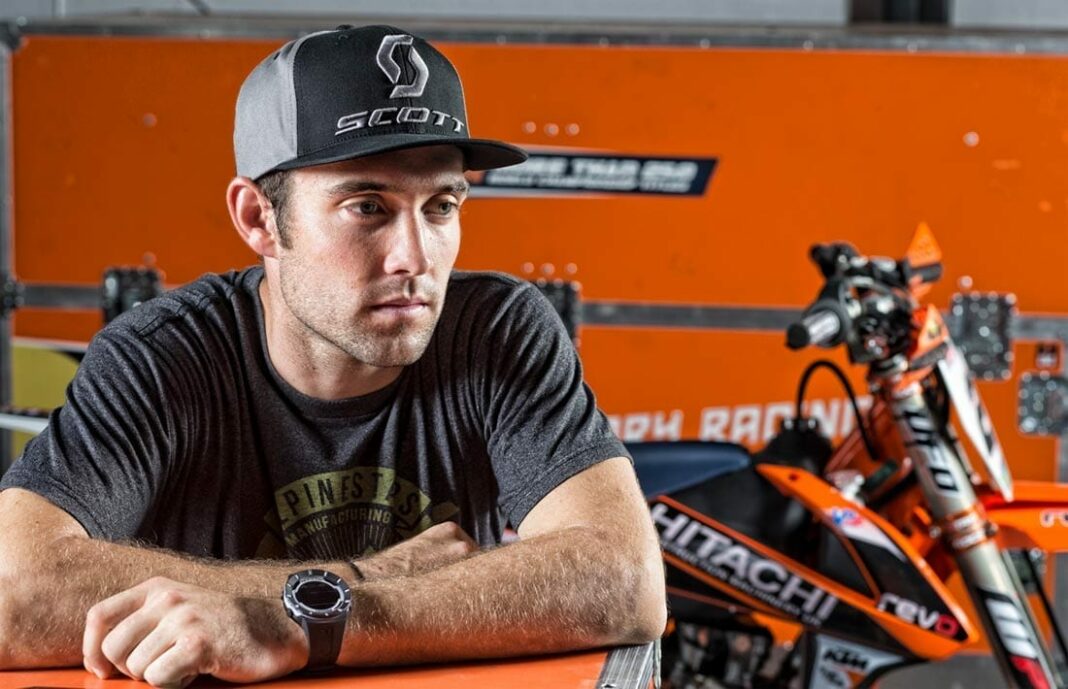How MXGP’s top privateer, Shaun Simpson, rose to the position of Grand Prix winner and KTM’s lead athlete in the FIM Motocross World Championship.
Survive, last, endure. Sometimes being the fastest rider is not as important as being the one that is constantly on the line, the one who can make it through to the end. 18 rounds with a Qualification Heat and two ‘motos’ per event, FIM World Championship Motocrossers have to negotiate a lot of race mileage throughout a season.
Throw in testing, training, national championships and international appearances and these guys are probably on a bike – at speed – more than any other motorcycle racer.
In 2015 Hitachi Construction Machinery Revo KTM’s Shaun Simpson has defied the largest entry list of factory-backed racers in recent memory to scale the MXGP standings to fourth, claimed his second British Championship in a row (seven of eight rounds unbeaten so far in the UK), win two Grand Prix (Belgium and Holland) to become the UK’s most successful racer ever in the premier class, finished fourth in his first AMA Pro National event at Unadilla and represented his country for the fourth time at the Motocross of Nations.
It has been a busy time for the 27-year-old who has managed all of it largely by himself on older 2015 machinery and with the help of father/mechanic/former rider Willie.
“I think I am a bit of a one-off,” the articulate Scot says as we sit down to talk about his season over a Starbucks in Mexico before he would later take second place overall to World Champion Romain Febvre.
“Many guys help with their bikes or could change a filter or an engine but I literally do a second mechanic’s job as well as being a professional racer, or I was up until Mantova time [round 15 of 18 when Simpson was giving help from Mattighofen and the injured Ken De Dycker’s 2016 works KTM 450 SX-F to replace his ’15 model].”
“I think the drive is there to push so much just because of myself, and my Dad. He is such a driven individual who just wants to see the best for his boy. It rubs off on me. We’ll be at home trying to relax and he’ll be thinking about suspension or engines. Deep down I’ll just want half an hour to chill, have a tea and watch the latest episode-of-whatever but that drive to keep on working and thinking like that every weekend is tiring. We are always striving for better.”
Can you give an example of things you have to do that perhaps a factory rider doesn’t?
“A lot of planning and work for the overseas with the flight cases and carnets. All the paperwork. I talk with the sponsors that come through the team but I have quite good personal relationships with a lot of them like Moto Master, Renthal, UFO, HG Stickers. Ordering stickers for the team, ordering brake pads, brake discs, going to see the companies and pick up the material. Sometimes I spend all morning in my van running errands and doing 2-300kms to collect everything. The guys from HGS exhausts were apparently quite surprised the first few times I turned up at their factory to get my own material!
“I am just trying to graft as much as I can to make things as easy as I can for us. Before Qatar I was packing the flight case until three o’clock in the morning and then went riding a few hours later.”
So that must impact your other work as a pro racer?
“Sometimes it is not the best preparation but it was the set of cards I was dealt with at that point [the end of 2013] and I had to run with it to go racing.
“Sometimes when Dad was busy or heading off to drive to a GP then I’d have to load my practice bike myself and go out for training. I remember going to Lommel once with my Vito, my toolbox and a little box of spares. I pulled out my own bike and put it on the stand and Kawasaki was there with [Ryan] Villopoto and [Tyla] Rattray next door with four mechanics and a suspension guy. In total there were eight of them and just me!
“I was going around doing my motos while they were riding and testing; it was such a contrast. At the end of the day Villopoto and Rattray would be away eating, spinning, having a sauna or whatever whereas I’d be at the workshop spraying my bike off, lube-ing the chain, WD40-ing it ready for the next day. I’d finally get home at eight o’clock and would prepare food and have to miss a gym session.
“The next day I’d have to re-pack, or get the camper organized to drive to a Grand Prix – it’s all just a small insight to how the weeks roll. At some points you think ‘shall I scrap practice today? Bugger it, I won’t go, I’ll get up, have the right food, go for my spin, sauna, get packed, organised with emails, rest and sort the camper’ but then you have missed out on the key part of getting ready, which is your riding. Everyone knows riding and practicing is the best thing you can do. So sometimes you just have to power through it and from the outside it just looks a bit mental.”
What about limits? Factory riders can swap bikes, put in new engines and whatever components they need. What is it like for you?
“Don’t get me wrong, the budget in the Hitachi Team is good to do stuff on a good level and we won at Lommel [Belgium] like that. We had enough stuff and we were not scrimping or screaming for material but there is a limit. For example we’d have to run second-hand plastics and stickers as we’ll need to save them for the next race. We’ll need to make an engine last a certain amount of races and so on.
“We are always planning in advance and judging and assessing the material. If we have a doubt sometimes we have to think ‘we’ll just have to go with it and see’. You have to make the best of what you’ve got. You keep bolting your bike together week after week and make sure it runs and finishes the races. We lose out on the testing, developing and being able to raise the bar – that all comes last or far down the list or priorities. Your main focus is: get back, get training, get the bike ready and make sure it is reliable and it will finish the motos. Where can you fit testing and development into that if you are racing every weekend? You might weaken the chance of reaching the flag if you are testing new stuff.
“This is where the factory or factory-supported teams are in a much better position because they have more staff and people who can get out and do that. Being in a privateer set-up means that handlebar grips last a couple of weeks, sprockets are not changed for a while. You have to often think ‘that will have to do’ because you might not have new replacements or doing things like using a second hand tire in a session because you don’t have wheels ready to go. Sometimes you could really test two different tyres in a warm-up session but having two wheels prepped for that time, well, that’s factory stuff.”
You and your father seem to take very special care of the equipment …
“I don’t think there are many other guys on our level who could achieve the performance and results that we got out of that [2015] bike. On the flip side when you have a factory bike or support then everything feels fresh, the engines are nicer and everything is just 100 per cent. Our 2015 bike felt tight and beautiful for two or three races but once we’d started using it for six, seven, eight races it got old and tired and you could feel that.
“A factory machine feels fresh, tight and new every time. When you jump on and it’s nice, responsive and crisp it gives you this special feeling and it is like having a new toy all over again. It is motivating. Factory bikes also have that special glean – not saying ours didn’t look nice – with titanium covers and parts everywhere. It never looks tired because of the amount of budget and guys around it.”
Being a privateer you need to be super-organised but perhaps one of the few advantages is the freedom to do what you want?
“Yeah, the good factor of being a privateer – or in that scenario – is that there is a lot more freedom to do a lot of things. If you decide that in the course of one week you want to completely change the engine character and take a risk on it being better then you can do that. Sometimes factory teams think ‘that is not tried and tested’ or ‘it hasn’t been endurance ran; we’re not going to do that’. When you are your own there are less rules and regulations and more make-it-up-as-you-go-along. Roger Magee [Team Principal] has largely left us to our own devices and I’m grateful to him for just letting us go racing our way because it has worked. There are Pros and Cons on every side.”
Have there been any ‘banging your head on the table’ moments?
“A lot! Many times during the season. I’ll be driving back through the night after a GP and people ask me ‘why don’t you just park up and get back late on the Monday?’ but the truth is that I have so much to do and this-and-that deadline before leaving on Wednesday again. You are surrounded by lists and iPad to-dos, emails to reply to and all my own current affairs and personal sponsors to attend to.
“Sometimes you look around and you don’t know how or why you get up to tackle it. Sometimes it can just be a nice message from Rachel [McIntyre, his fiancée] or you think ‘how many other people in the world have it worse than me?’ or ‘how many would love to be in my position?’ I’m sure loads think: ‘Shaun’s got it easy, riding well and living the life’ but if they lived in my shoes for a week they’d think ‘wow: respect for that’.
“I like my life and the rewards like GP wins and British Championships. I know what I have got and how much I have worked for it. I’m a working class guy and sometimes I feel spoilt when people are giving me stuff or when I get a good result. I almost feel guilty. At Assen I thought ‘if it wasn’t me standing on the top step then someone else would happily be there’.”
KTM started to support you from round 15 both in GP and the AMA. You are now back in the factory-support mould for 2016 …
“And I’m really grateful for that. Their support has been amazing and convinces me even more that I am on the edge of pushing up even higher in my career. I’ve gone from 15th to 12th to ninth to seventh and now I am fourth in MXGP. As a rider – whether you are in a factory awning or out the back of a van – you just want to do the best you can on the machinery you have and when it comes to things like your physical condition.
“I won with almost nothing in 2013 and then at a better level in 2015 and it gives you the same boost of confidence and that feeling of ‘I’ve done it’. And that journey can involve many different factors. The road to winning can bend like a piece of spaghetti, involving training, support, equipment, confidence. There are only four guys who have managed a double moto win this year. You go from feeling like an outsider and not a factory rider to actually being right in the mix with the top cream of MXGP and names like Paulin, Cairoli, Desalle.
“You look at riders like Strijbos and Bobryshev who had not won in a while and your mind lets you think ‘wow, I’m better than these guys’. Stats and black-and-white tell a story. When you start looking at the numbers you realise that it is not a fantasy anymore and it sinks in. It gives you the drive to go on week after week. When I go out on the track now it might not be sand but it doesn’t matter – I’m the guy who has gone out and beaten all the rest.
“Your mind is a big thing in sport. You can be the most talented or the fittest but if you are weak in the mind then you are going to struggle. I think it is something everybody works on but I have learnt a lot more about it and myself in the last couple of months.”
Step away from the last two years for a moment. What are your feelings on this phase of your career?
“I always felt lucky when I was in a factory team before and it is only when you step away do you actually think you were twice as lucky. To be able to return to that for 2016 and some sort of factory style of living I guess I feel I deserve it. I think a lot of people might have thrown the towel in if they had to do what we do, or they would start to ‘let it slip’. I know I have put 100 per cent into what I’ve had. It might not have been 100 per cent in training, eating or sleeping or diet but what we have taken out from what we have put in on the main parts has me feeling like I deserve to be back in the position to being spoiled again. I’ll be able re-channel that areas I have put into 2014 and 2015 into other parts for looking towards the next step.”









